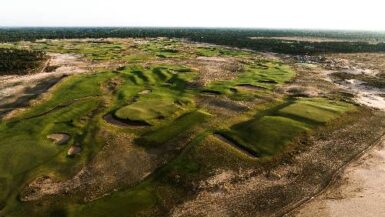The first part of this article is here.
I noticed an evolution of Jim’s bunkering at Blackstone Country Club in Peoria, Arizona, but did not consider it a permanent departure until he repeated the design at Creek Club. In Jim’s earlier work – Fossil Trace and Redlands Mesa for example – Jim’s muscle bunkers were actually sinkholes. The floor of the bunker was below the level of the fairway or green by about three or four feet. The muscled sidewalls were within the confines of the bunker.
A few people mentioned to Jim that they had difficulty getting in and out of the bunkers. Most of these players were older. “My wife and I had a problem getting in and out of the bunkers” said one expert golfer and course reviewer. “We mentioned this to Jim when we met him. We love his courses, but thought he could make them even more playable if people could get in and out of the bunkers more easily.”
Lo! and behold! – Jim actually listened to them. Starting at Blackstone and continuing at Creek Club, Jim made the floor of the bunkers level with the fairway, then he built the enormous sidewalls towering over the fairway level. “The people spoke and I listened. I could make an equally challenging hazard, yet one that you could walk in and out of in a straight line without having to climb” Engh says helpfully.
If the lesson here is lost on you, let me break it down like a fraction: the people spoke and the architect listened. “Wow!” gushed my friend. “That’s so great that he listened to us. What a super guy.”
Rock guitarist Chris Burney from gold record award winning band Bowling For Soup agrees. “Those bunkers I saw at Blackstone were unique. I’ve never seen anything like it. It’s bold, yet it looked like those quirky, but charming dunes in Ireland. Blackstone is my favorite course ever because it took a lot of courage to make something that looks different, but plays like a course abroad.”
Fan approval aside, I have to respectfully dissent. I like the new look, but I like the old look better. More importantly, I think the new bunkers are actually harder to clambor through, over and around. Where before, you simply took a few steps down, then back up, I find that I rarely if ever enter and exit the new style bunkers from the level areas. The bunkers are so enormous, that my ball is frequently in the middle or near a sidewall. As a result, I think players do more trudging in, through, and around the bunker than ever before. Jim may have outsmarted himself here; I think the new style are definitely a tougher walk. The simpler answer to my friend’s dilemma was to merely add some stairs to the sinkhole style bunkers: problem solved.
Additionally, gigantic mounds in the center line of play limits airspace. Instead of having to clear a few feet of bunker lip, now you have to clear a significantly higher lip. However, I don’t find the added difficulty a negative. To me, no bunker is unfair no matter where it is placed or how deep it is. I simply note that generally more airspace helps the average player, but hey, we’re not supposed to build courses to cater to the worst player in the world, just build them to give them a fighting chance to get around such a fearsome hazard. Jim has done that. If you are scared of the new bunkers, don’t hit the ball in it. If you do, find it and hit it out. As Old Tom Morris said, “Bunkers are not places of pleasure; they are for punishment and repentance.”
Moreover, we’re counting the number of angels that dance on the head of a pin. If both rock stars and the Southern Gentlemen and Ladies of Reynolds like them, Jim’s evolution has broad appeal. Both styles are equally functional and esthetically pleasing. Purely as a suggestion, I would hope Jim might consider employing both styles, depending on the terrain of his sites and the clientele. Older clientele that might tire easily and sites that call for a little hurly-burly bunkering can have the new style of muscle bunker. At other sites, simply use the old style with stairs. That way, Jim has two different stage props in his arsenal – both equally effective as hazards and pleasing to the eye, depending on the beholder.





Leave a reply
You must be logged in to post a comment.